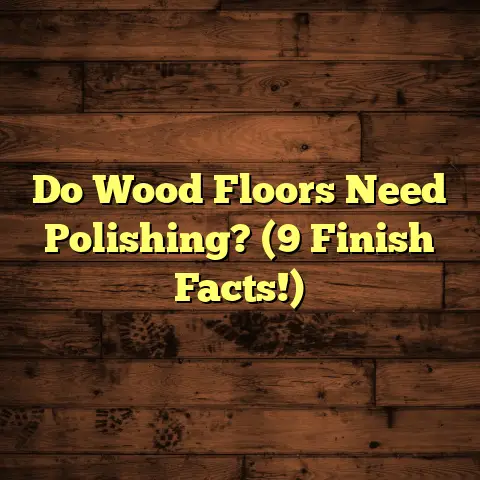Concrete Floors Like Hardwood? (2 Design Must-Sees!)
Let me let you in on a little secret that’s been making waves in the design world: concrete floors.
Yep, you heard right!
Concrete isn’t just for sidewalks and basements anymore.
It’s quickly becoming the go-to choice for homeowners and designers who want a blend of style, durability, and sustainability.
Now, I know what you might be thinking: “Concrete? That sounds cold and industrial!”
But trust me, the concrete floors of today are nothing like the drab, gray slabs of the past.
With the right techniques, you can actually achieve the warm, inviting look of hardwood floors – but with a whole lot of added benefits.
Think of concrete floors as the “best-kept secret” in interior design.
Many are still unaware of the stunning possibilities, especially when it comes to mimicking the beauty of hardwood.
I’ve seen firsthand how concrete can transform a space, and I’m excited to share my insights with you.
In this article, we’ll dive into the world of concrete floors and explore how you can achieve that coveted hardwood aesthetic.
I’ll share some insider tips, industry secrets, and real-life examples to inspire your next flooring project.
So, grab a cup of coffee, get comfy, and let’s explore the amazing potential of concrete floors together!
The Allure of Concrete Floors
The Rise of Concrete in Home Design
Concrete has been around for ages, right? But its journey from purely functional to fashionable is quite interesting.
Initially, concrete was mainly used in industrial spaces, like warehouses and factories, because of its strength and durability.
I remember back in the day, concrete was all about practicality, not aesthetics.
But over time, architects and designers started seeing the potential beyond its utilitarian purpose.
They began experimenting with finishes, colors, and textures, and that’s when concrete started making its way into residential homes.
There are several reasons behind this resurgence.
First, there’s the economic factor. Concrete is often more affordable than traditional hardwood, especially when you factor in installation costs.
Then, there’s the growing environmental consciousness. Concrete can be a sustainable choice, especially when using recycled aggregates and eco-friendly sealers.
And let’s not forget the aesthetic trends. Modern and minimalist designs have embraced the clean, industrial look of concrete, making it a popular choice for contemporary homes.
I’ve noticed that homeowners are increasingly drawn to concrete because it offers a unique blend of style and sustainability.
It’s a material that can be both raw and refined, making it incredibly versatile for different design styles.
Concrete vs. Hardwood – A Comparative Overview
Alright, let’s get down to brass tacks and compare concrete and hardwood side-by-side.
I’ve worked with both materials extensively, and here’s my take on the key differences:
| Feature | Concrete | Hardwood |
|---|---|---|
| Cost | Generally lower initial cost | Higher initial cost |
| Durability | Highly durable, resistant to scratches and dents | Susceptible to scratches and dents |
| Maintenance | Low maintenance, easy to clean | Requires regular maintenance, polishing, and refinishing |
| Design Flexibility | Can be stained, polished, and textured to mimic various looks | Limited to natural wood colors and grains |
| Environmental Impact | Can be sustainable with recycled materials and eco-friendly sealers | Deforestation concerns, requires harvesting of trees |
| Lifespan | Extremely long-lasting, can last for decades with proper care | Can last for decades, but requires more maintenance |
As you can see, both materials have their pros and cons.
Hardwood is classic and beautiful, but it requires more upkeep and can be more expensive in the long run.
Concrete, on the other hand, is incredibly durable and versatile, but it might not have the same inherent warmth as natural wood.
From an environmental standpoint, concrete can be a more sustainable option.
According to the Portland Cement Association, the cement industry is continuously working to reduce its carbon footprint through innovations in production processes and the use of supplementary cementitious materials (SCMs) [^1^].
I’ve found that many homeowners are choosing concrete because of its longevity and minimal upkeep.
Once it’s properly sealed and finished, you can enjoy a concrete floor for decades with minimal maintenance.
Design Must-Sees – Transforming Concrete into Hardwood-Like Aesthetics
Okay, now for the fun part!
Let’s explore how you can actually transform concrete into a stunning hardwood-like floor.
I’ve got two design must-sees that will blow your mind:
Design Must-See #1 – Stained Concrete Finishes
Staining concrete is like giving it a makeover.
It’s a transformative technique that allows you to customize the color and create a hardwood-like appearance.
There are two main types of concrete stains: acid-based and water-based.
Acid-based stains react with the minerals in the concrete, creating unique, mottled effects.
They penetrate deeply and produce rich, permanent colors.
Water-based stains, on the other hand, are more predictable and offer a wider range of colors.
They’re also more eco-friendly and easier to work with.
I’ve used both types of stains on various projects, and each has its own unique advantages.
For example, I once worked on a residential project where the homeowner wanted to replicate the look of dark walnut hardwood.
We used an acid-based stain to achieve that deep, rich color with subtle variations that mimicked the natural grain of wood.
The result was absolutely stunning!
Everyone who walked into the house thought it was real hardwood.
To achieve a convincing hardwood look, consider using multiple stain colors to create depth and dimension.
You can also use stencils or masking techniques to create patterns that resemble wood planks.
I’ve seen some incredible results using these techniques, and the possibilities are endless.
Design Must-See #2 – Concrete Polishing Techniques
Polishing concrete is another fantastic way to achieve a sleek, wood-like finish.
The process involves grinding the concrete surface with progressively finer diamond abrasives to achieve the desired level of sheen.
You can achieve different levels of sheen, from matte to high-gloss, depending on the number of polishing steps.
A matte finish can create a more rustic, natural look, while a high-gloss finish can mimic the look of polished hardwood.
I’ve found that polished concrete floors pair beautifully with modern and minimalist furniture styles.
The clean, sleek surface creates a sophisticated backdrop that enhances the overall design of the space.
For example, I once worked on a commercial project where we polished the concrete floors to a high-gloss finish.
We then paired it with mid-century modern furniture and decor, creating a stylish and inviting space.
The polished concrete not only looked amazing but also provided a durable and low-maintenance flooring solution for a high-traffic area.
To enhance the hardwood illusion, consider adding saw cuts or scoring patterns to the concrete surface.
These lines can mimic the look of wood planks and add visual interest to the floor.
I’ve seen some incredible designs using this technique, and it’s a great way to customize the look of your concrete floor.
The Practical Benefits of Choosing Concrete
Durability and Longevity
Let’s talk about the practical side of concrete floors.
One of the biggest advantages of concrete is its incredible durability.
Compared to hardwood, concrete is much more resistant to scratches, dents, and moisture.
It can withstand heavy foot traffic, pet claws, and spills without showing signs of wear and tear.
I’ve seen concrete floors that have lasted for decades with minimal maintenance.
In fact, many historical buildings feature concrete floors that are still in excellent condition.
Hardwood, on the other hand, requires more regular maintenance and is more susceptible to damage.
It can be scratched by furniture, dented by heavy objects, and warped by moisture.
According to the National Wood Flooring Association, proper maintenance is essential to prolong the life of hardwood floors [^2^].
I’ve found that homeowners with pets or young children often prefer concrete because it can withstand the rigors of daily life without requiring constant upkeep.
Cost-Effectiveness Over Time
Now, let’s crunch some numbers and talk about cost.
While the initial installation cost of concrete flooring can vary depending on the complexity of the project, it’s generally more affordable than hardwood.
According to HomeAdvisor, the average cost to install concrete flooring ranges from $3 to $8 per square foot, while hardwood flooring can range from $6 to $12 per square foot ^3^.
But the real cost savings come in the long term.
Concrete floors require minimal maintenance and can last for decades without needing to be replaced.
Hardwood, on the other hand, requires regular maintenance, such as polishing and refinishing, which can add up over time.
It also has a shorter lifespan and may need to be replaced sooner than concrete.
I’ve worked with homeowners who have saved thousands of dollars over the years by choosing concrete flooring instead of hardwood.
The low maintenance and long lifespan make it a cost-effective choice for homeowners who want a stylish and durable flooring solution.
Conclusion: Embracing the Best-Kept Secret of Concrete Flooring
So, there you have it!
Concrete floors are no longer just for industrial spaces.
They’re a stylish and practical alternative to hardwood that can transform your home.
From stained concrete finishes to polished concrete techniques, there are endless possibilities for creating a stunning hardwood-like aesthetic.
And with their durability, longevity, and cost-effectiveness, concrete floors are a smart choice for modern interiors that don’t compromise on aesthetics.
I encourage you to consider the innovative and versatile options available in concrete flooring design.
Embrace the “best-kept secret” and explore these designs for your own spaces.
You might be surprised at how beautiful and practical concrete floors can be!
References
[^1^]: Portland Cement Association. (n.d.). Sustainability. Retrieved from https://www.cement.org/ [^2^]: National Wood Flooring Association. (n.d.). Care and Maintenance. Retrieved from https://www.nwfa.org/





